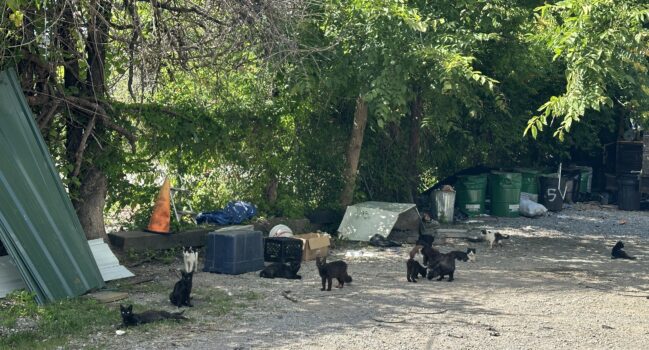Once the cats you’re feeding have been eating between 5 p.m. and 6 p.m. every day for at least a couple weeks, you’ll be given a date that we’ll come out to begin trapping. While we aim to give at least one week’s notice, occasionally we’ll have last-minute cancellations that we try to fill. We will always confirm with you before we schedule your colony for TNR. Read on for more details about what to expect on trapping day:
When do we trap?
Most often, we trap once a week on Tuesday evenings because we have guaranteed surgery spots on Wednesday mornings. All of our volunteers work full-time jobs so trapping begins after we get off work, usually between 6 p.m. and 6:30 p.m. We’ll text you when we’re on our way to your location.
How can you prepare on trapping day?
The single most important thing you can do on trapping day is to not put out any food at all that day, and if you have neighbors who leave food out please ask them to take it up that morning. Check your feeding station the morning of trapping day, and remove any leftovers from the night before. The cats will be taking a big risk by walking into our traps, and they need to be expecting food by the time we arrive. Then when we set our traps, baited with food, they need to be hungry enough to go inside.
What happens during the trapping process?
We ask that you stay inside your house or business when we first arrive, unless we’ve discussed otherwise. Cats are very smart, and once they see our traps they’ll know something is going on. We need to be able to set our traps quietly and quickly without any commotion. After the traps are set, we might text to ask you to come outside and pretend to feed (shake a bag, call their names, go through your usual routine without actually putting food down) and then go back inside. Sometimes if cats see the familiar ritual of feeding time, they’ll feel more confident going into the traps.
As cats are trapped, we immediately cover them and move them to our car one by one.
We stay throughout the entire process—traps are never left unattended during TNR, although we will hide in our car, behind trees, around a corner, etc., so the cats will be less suspicious and more likely to go into the traps.
How long does trapping take?
This depends on how hungry the cats are, and how ingrained their evening feeding routine is. If the cats are used to eating around 6 p.m. every day, haven’t had a meal in 24 hours, and are there waiting when we arrive, trapping can take less than an hour. Some cats are more suspicious and may take a bit longer to decide to go into a trap, and sometimes cats run when they see us and don’t come back at all while we’re there. We’ll trap until one of the following happens: We’ve trapped as many cats as we have surgery spots for, no more cats have been seen at the colony for a bit, or the cats are around but are not hungry enough to go into the traps. If needed, we’ll schedule a follow-up trapping day with you when we leave.
What happens after the cats are trapped?
Once we’ve wrapped up trapping for the evening, we take the cats back to CHAFCA headquarters where they are held in our pre-surgery/recovery space. The next morning they’re brought to the veterinary clinic for spay/neuter, vaccines, and ear tips, and later that day we pick them up and bring them back to our recovery space. Cats are kept covered, in their traps, the entire time they’re with us. We feed the cats the night before surgery and the night after, and change their pee pads if they soil them.
When are the cats returned?
The morning after surgery we check to make sure the cats appear alert and well, and we return them back to the exact location where we trapped them on your property. If you’d like to see their return we’re happy to text you when we’re on our way, but returns are done before our volunteers go to work and are usually quick—the cats are always ready to be back home! We’ll also ask that you leave food out that morning in case they’re hungrier than usual.
What’s next?
If there are still cats in your colony who need TNR, we’ll set up a date to return and continue trapping. Often this is scheduled for the following week, but if we’ve been trying and failing to trap cats at your location, we’ll likely recommend taking a break to let the colony “reset”—i.e. let the cats forget about us for a few weeks. We may bring you a training trap, which is a humane trap that’s been modified so that it can’t close on the cats while they’re inside of it. We’ll ask that you feed the cats exclusively inside the training trap so they learn eating inside traps is safe, and then when we return we swap out our working traps for the training trap.
If we’ve trapped all of the regulars at your colony, congrats! You now have a stabilized community cat colony. The existing, sterilized cats should do a good job at keeping other cats away, but if you have newcomers become regulars please reach out to us and we’ll be happy to come back out to TNR them as well.


